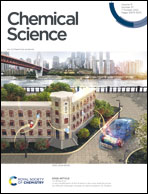Investigating the role of the strong field ligands in [FeFe] hydrogenase: spectroscopic and functional characterization of a semi-synthetic mono-cyanide active site†
Abstract
Artificial maturation of hydrogenases provides a path towards generating new semi-synthetic enzymes with novel catalytic properties. Here enzymes featuring a synthetic asymmetric mono-cyanide cofactor have been prepared using two different hydrogenase scaffolds. Their structure and reactivity was investigated in order to elucidate the design rationale behind the native di-cyanide cofactor, and by extension the second coordination sphere of the active-site pocket. Surprisingly, the choice of host enzyme was found to have a dramatic impact on reactivity. Moreover, the study shows that synthetic manipulations of the active-site can significantly increase inhibitor tolerance, as compared to native [FeFe] hydrogenase, while retaining the enzyme's native capacity for reversible catalysis.
![Graphical abstract: Investigating the role of the strong field ligands in [FeFe] hydrogenase: spectroscopic and functional characterization of a semi-synthetic mono-cyanide active site](/en/Image/Get?imageInfo.ImageType=GA&imageInfo.ImageIdentifier.ManuscriptID=D2SC02271K&imageInfo.ImageIdentifier.Year=2022)
- This article is part of the themed collection: Editor’s Choice: Vincent Artero


 Please wait while we load your content...
Please wait while we load your content...